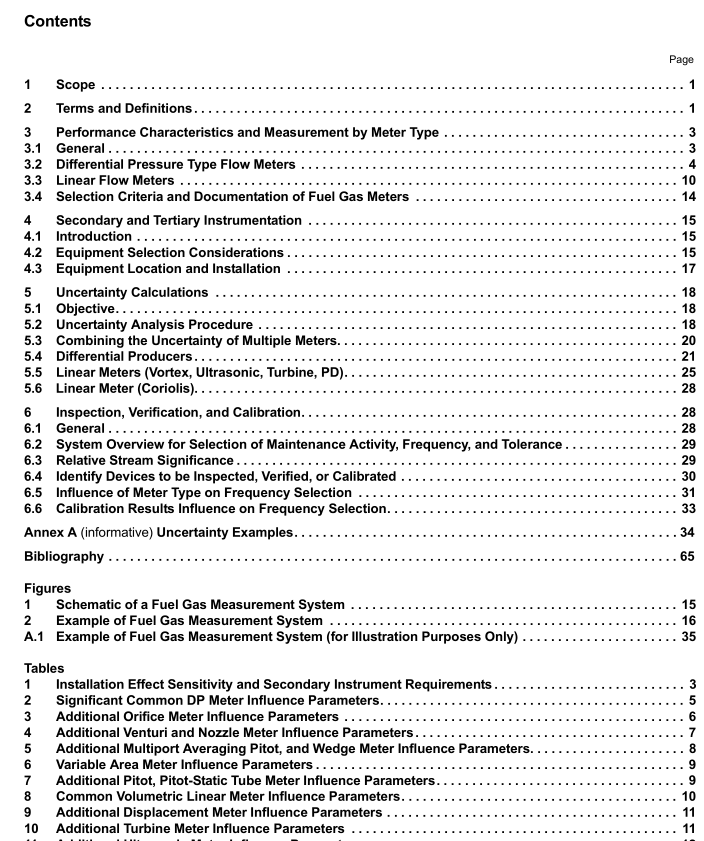API TR 2571 pdf download

API TR 2571 pdf download Fuel Gas Measurement
3.3.6 Thermal Flow Meters
Thermal flow meters (often referred to as thermal mass meters) operate on the principle of thermal convection or dispersion. The major components of thermal flow meters are resistance temperature detectors (RTDs), a heater, and control electronics. Thermal flow meters are typically available in insertion and in-line mounting types, and may have either single or multiple sensing locations. Two examples of thermal flow meters are constant differential temperature and constant power thermal flow meters.
Constant differential temperature thermal flow meters use a heated RTD which is compared and continually adjusted to maintain a constant temperature difference with respect to the process temperature measured by a second RTD. The power required to maintain the constant temperature difference is proportional to the rate of heat loss from the heated RTD. Constant power thermal flow meters apply constant power to heat the active RTD and measure the temperature difference between the active RTD and the process temperature measured by a second RTD.
In both types, the rate of heat loss is proportional to the heat transfer coefficient of the assumed gas mixture and the flow rate at the sensor. Thermal flow meters have significant sensitivity to variations in gas composition and are affected by deposits or coatings on the sensor and variations in process pressure and temperature that affect the gas density. Thermal flow meters are not recommended for applications where liquid droplets or liquid mist are normally present, because this significantly impacts the heat transfer rate. The insertion depth and the orientation of the meter are specified by the manufacturer. See Table 13.
3.3.7 Coriolis
Flow Meters Coriolis flow meters utilize a law of physics known as Coriolis force that is exerted by the fluid mass passing the flow tubes when the flow tube(s) are oscillated perpendicular to the flow direction. Fluid passing through the oscillating tube causes the tube to deflect as the flowing mass exerts force against the movement of the tube. Coriolis meters are designed with a single tube or a pair of tubes. The phase difference between two locations on the oscillating tube(s) is detected by a pair of sensors and is proportional to the mass flow rate. Coriolis meters can also provide a density measurement of the fluid being measured. However, for fuel gas applications the uncertainty of the measured density can be significant. Therefore, for fuel gas applications Coriolis meters are generally configured to output in mass, and converted to standard volume using a separately measured or determined standard density. Coriolis meters are insensitive to the velocity profile.
Since the Coriolis meter measures flow rate directly in mass, measurement is not influenced by the fluid pressure, temperature, composition, or density. However, the stiffness of the tubes determining the mass flow rate is weakly influenced by the temperature and pressure of the flowing fluid especially for fuel gas applications. The influence of pressure and temperature on the tube stiffness is corrected by the electronics of the meter with input of the operating pressure and temperature. Almost all Coriolis meters have integral tube temperature monitoring capability. Coriolis meters can be provided in either straight or curved tube designs. Depending on the meter design, pressure loss for a Coriolis flow meter can vary significantly. See Table 14.
3.4 Selection Criteria and Documentation of Fuel Gas Meters At the time of development of this document, fuel gas meters installed in the petrochemical industries were typically the meters listed above in this section. It is important to note that there are constant improvements in the fields of meter design, secondary instrumentation, and most importantly, in reducing the measurement uncertainty. These improvements allow users to extend the frequency of performance verifications of the installed meters. The emphasis of performance verification should be based on the total measurement uncertainty for the complete measurement system, and not on the performance of individual components of the metering system. The fuel gas meters described in this section represent a reasonably comprehensive list covering an estimated >95 % of petroleum manufacturing installations in the USA. Any gas meter with a technically defensible and documented measurement uncertainty within acceptable performance requirements can be installed to monitor or measure the fuel gas usage by the industry.









